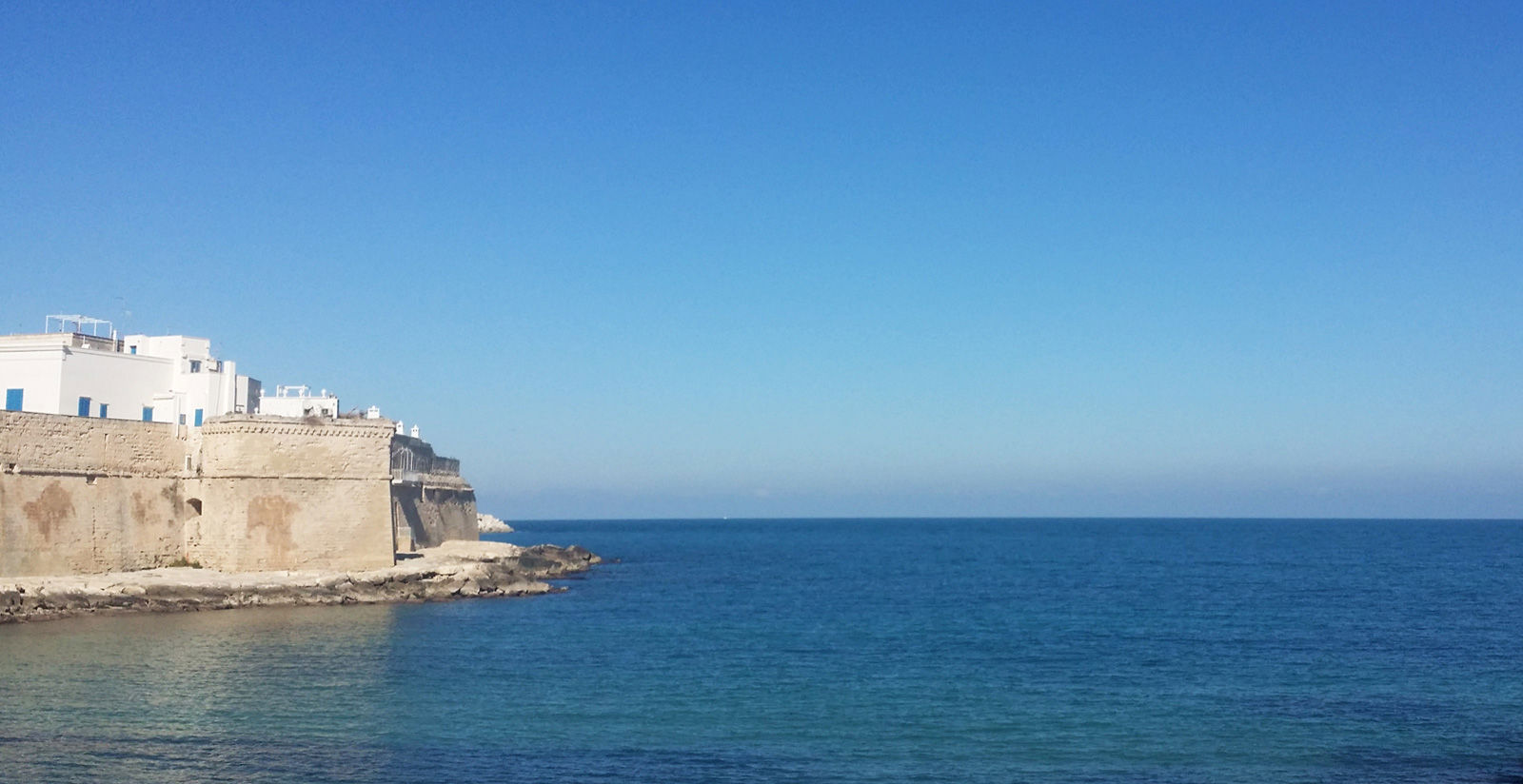It is located 43 km to the south-east of the chief town and is the most highly-populated non-chief town in Puglia south of Bari.
Monopoli represents one of the region’s most active and populated ports among the Apulian towns and cities located along the Adriatic coast.
Its characteristic historic centre looks out onto the sea, gracing the coastal panorama with its ancient, high town walls, a medieval bastion that the town’s history still boasts of.
Monopoli is also known as the town of 100 contrade. Indeed the surrounding area is split into various locations, known as contrade, each of which bearing a name that recalls either an ancient fortified farm house (e.g., Chianchizza), or the presence of a church (e.g., San Gerardo, San Vincenzo). In some cases, said contrade are even an ancient legacy of the splitting of the countryside into feuds.
Castle of Charles V
This is a sixteenth-century fort build during the Spanish domination of the town of Monopoli.
The traditional, pentagonal layout of sixteenth-century forts is added to with towers that rise up at each of the five corners.
The drawbridge (and hence the main entrance) must have been located to the south-east where you can find a round tower, built at a later date, that can be accessed via a small ramp.
A well-conserved part of the ancient walls can be seen to the left of the tower. The splayed openings for canons along the top of the walls are not to be missed.
A stone coat-of-arms bearing the date of 1552 and the name of the viceroy Don Pedro di Toledo, that was actually responsible for constructing the building, can be found under the loggia.
The building offers a number of features of artistic and historical interest:
The rural church of San Nicola de Pinna, founded at the end of the 10th century by a local inhabitant, Sassone.
An element that generates great doubt among experts is the large door built of squared blocks bearing the vertical eyelet of a bolt no longer present which represents the building’s most mysterious feature.
An unknown historian from the 1700 told how, at that time, people used to fish for coral under the castle and it seems that said coral was once plentiful in the underlying waters.
Palazzo Palmieri (18th century)
The building is located in the town’s oldest square: cut-off on the eastern side, it has a main floor and central forepart(two columns to support the balcony and the family coat-of-arms).
The square, used to serve the Marquis Palmieri’s palace, traditionally belonged to the ancient Romanesque church of St. Peter (4th century).
In 1585, some followers bought some houses in the old town and converted all of them into an institution known as 'Conservatorio della Casa Santa'. Under the rule of the Bishop Antonio Porzio during the 17th century, complete seclusion was ordered with granting of use of the robes of the Blessed Virgin of the Presentation for all the poor female orphans expressing a desire to be part of a religious order.
The former Town Hall
Former Spanish barracks converted into the town hall and subsequently into the town’s theatre, it is now home to the town’s library thanks to the Senator and Professor Luigi Russo.
It bears the name of Monopoli’s famous, well-known jurist, Prospero Rendella (1553 - 1630) ‘Friend of the Muses’, exemplary and noble figure of the Renaissance in the South of Italy.
The facade, featuring two loggias one on top of the other (the top loggia has, however, been recently renovated) is the main attraction of Piazza Garibaldi with its Venetian colours.
The library is closed for renovation until December 2009.
Castle of St. Stephen
The Castle of St. Stephen is a fort located in Monopoli (Italy). It represented Monopoli’s most important coastal defence system throughout the whole medieval period.
Piazza Vittorio Emanuele (19th century)
One of the largest squares in Puglia and in Italy, designed in 1796 following approval by the King of Naples, it was built in accordance with the design by the royal architect, De Simone: the design comprising orthogonal links, straight streets and perpendicular side streets is functional and does away with the classical rules, much in fashion at that time. In 1872 the square was renovated by the architect, Losavio who, having abandoned the idea of a Renaissance square, opted for the more affordable and also more modern idea of a garden square. He split the square into two tree-lined rectangles and added new urban features. While it proved necessary to wait until 1893 before the trees were added, it was possible to immediately open up the road which runs from the east into Largo Plebiscito, while on the other side it stretches out to form a sort of decumanus of the town’s entire chessboard layout. The monument to dead soldiers stands in the southern rectangle and was the work of the sculptor Edoardo Simone from Brindisi, who built it in 1828, loyal to the 19th-century sculpture and oratory style of Bistolfi, Sartorio and other popular artists of the period.The monument is the only one in Italy to have been erected not for the heroes, but for the heartbreaking pain of the relatives left behind, depicted with uncommon efficacy on the monument. In 1848 the square became the centre of an anti-Bourbon conspiracy: the liberals of Monopoli promoted a convention held by the Friends of Freedom.
On the morning of 18 May 1848 the town welcomed the conspiring convention participants. However, the plot failed since the two reactionary factions failed to agree and the conspirators were condemned to long, hard years of imprisonment.
A stone marks the place where they met, laid at the corner of Via Giuseppe Polignani.
Piazza XX Settembre
This is the home of the town’s daily fruit and vegetable market; just like all the squares and streets in Italy named in honour of 20 September 1870, the date of the Breach of Porta Pia, it leads to the town’s Cathedral.
But its specific feature, which makes is stand out from all the squares in Puglia, is the surface of the square that is paved with red tiles only.
Church of Santa Maria Amalfitana
Tradition has it that in 1059, some sailors from Amalfi, that had escaped a storm, disembarked to pray in a grotto belonging to Basilian monks located near to the cliffs where they had landed. They expressed their desire to the monks to create a sanctuary in the grotto and thus maintain their vow made to Our Lady.
One hundred years later, when the presence of this group had a more important role in this developing town, the Amalfitans built the Romanesque church on the site of said underground sanctuary which restoration work, carried out during this century, have brought to light.
The facade is still that of the 1700s, but the ancient arches and columns have been restored inside the church.
Cuisine
Monopoli’s cuisine has always had its own history given the lush woodlands and fish-filled Adriatic coast.
n fact, the dishes differ slightly between the town and the surrounding countryside given the different inclination of the population’s activity: maritime on the one hand and agricultural on the other. The most popular dishes include:
- Pettole : balls of soft, leavened dough (flour, potato, yeast, water and salt) fried in hot oil. They are served warm, dusted with sugar or with cooked wine or honey on 7 December for the feast of the Immaculate Conception, on 24 December and at some of the local feast days in the town’s contrade.
- Cartellate : pastries with honey or cooked wine. They are also served at Christmas. Possibly of Greek origin where many similar pastries are still served.
- Pruciddi: pastries with honey or cooked wine.
- Boconotti: pastries filled with jam and almond paste.
- Taralli: ring-shaped biscuits made using bread dough.
- Dough balls.
- Polpo in pignata: a soup made with octopus left to marinate in a sauce of onions, tomatoes and capers.
- Rice, potatoes and mussels: one of the main dishes of Bari (also called Tiella, from the dish used to cook it in) and the Monopoli area.
- Focaccia barese: a special type of bread made with home-made dough, similar to a thick, soft pizza, that can be topped with tomatoes and olives, or filled with onions or turnips.
The day when all the inhabitants of Monopoli eat this bread is the Feast of the Madonna della Madia when it is usually filled with mortadella and cheese. - Panzerotti: a dish prepared with home-made dough comprising round pizzas, filled with tomato and mozzarella, and folded over in half.
- They are then fried. There are a number of different varieties (with strong ricotta cheese or filled as you like).
- Orecchiette: made using durum wheat flour, served with turnip tops, tomato, basil and hard ricotta and with a sauce made using mushrooms found at the foot or on the trunk of the carob tree, the extremely rare Laetiporus sulphureus.
- Zeppola di San Giuseppe, a typical sweet from the South of Italy: fried or baked doughnuts, decorated with cream, cherries and cinnamon. They are made to celebrate the feast of St. Joseph.







